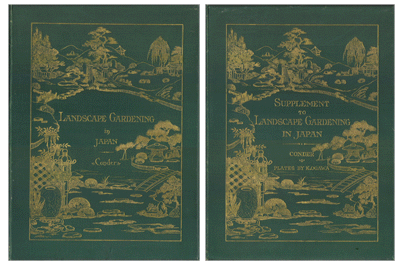
Larger Picture Here.
Conder, Josiah
Ogawa, Kazumasa (Collotype Illustrations - Supplemental Volume):
Landscape Gardening in Japan, 2 volumes, Tokio, printed by Hakubunsha, published and sold by Kelly & Walsh, 1893, large 4to (11 x 14.5 in - 28 x 36.7 cm), green cloth with extensive gilt decoration on front cover, back cover is blind stamped, beveled edges, decorated endpapers. Volume I contains 37 full page tissue guard protected plates (12 of which are tinted lithographs) and 161 numbered pages of text. Within the text there are 55 woodcut text illustrations. Volume II (Supplement) contains 40 black and white tissue guard protected collotypes with 60 different images. This work is a very early, comprehensive and well illustrated, Western language discussion of Japanese landscape gardening. The supplemental volume is, by itself, an important historical pictorial record of important gardens exiting in Japan in the late 19th century.
The first and primary volume presents the history of Japanese gardening followed by chapters dealing with various technical aspects of traditional Japanese gardens. These chapters include stones, lanterns, pagodas, water basins, enclosures, wells, bridges, arbors, ornamental water (including the use of lakes, rivers, streams and waterfalls in gardens), plants (detail lists given) and physical composition of the various types of gardens (hill, flat, tea, passage and fancy). All of these topics are lavishly illustrated in the accompanying text illustrations and plates. The supplemental volume contains collotype reproductions of photographs of gardens prepared exclusively by K. (Kazumasa) Ogawa. Most of the actual photographs were also taken by Ogawa. Conder presents these images to further illustrate the various types of gardens. Included are views of the famous Kinkakuji, Ginkakuji and Imperial gardens, as well as many privately owned gardens. The plates are preceded by a descriptive page text discussion of the history, location and type of garden. Also key aspects of the garden are discussed. Each plate has the plate number at the top in roman numerals and a descriptive title below each image.
Wenckstern gives the publication date for the Supplement as 1894. I have seen the Supplement with that date as well as the date of 1893.
A distinguishing feature of this set is the very high quality of the plates. In the first volume Conder used the more expensive and labor intensive tinted lithographic plates for 12 of the 37 plates. This is one of the few Meiji era Western language books relating to Japan to use this type of plate. In the second volume, Conder turned to the preeminent Japanese photographer, Kazumasa Ogawa, for many of the images and these were all reproduced by Ogawa through the high quality and labor intensive collotype process. The plates in both volumes are attached to a thin linen type strip and this is in turn bound into the spine. These factors combined with the fine printing and binding made this a very expensive set, even when first issued. Wenckstern noted the prices were $10.00 for volume 1 and $6.00 for the supplement.
The books were published and sold/distributed by Kelly and Walsh, Limited, Yokohama, Shanghai, Hong Kong and Singapore. They were printed by Hakubunsha, Tokio.
A second edition of this set was published by Shuyeisha, Tokyo, and distributed/sold by Kelly & Walsh, Yokohama in 1912.
The 25 year old English architect, Josiah Conder (1852-1920), arrived in Japan in 1877 (Meiji 10), responding to an invitation from the Japanese government to take a teaching position at the "Technical College." Conder is perhaps best known in Japan for his design of the Rokumeikan (literally "Deer Cry Pavilion") which was completed in 1883 after a 3 year construction process. He also designed the Imperial Museum in Tokyo. He studied painting under the famous painter, Kyosai. In 1911 his book on Kyosai titled Paintings and Studies by Kawanabe Kyosai. An Illustrated and Descriptive Catalogue of a Collection of Paintings, Studies, and Sketches, by the Above Artist, with Explanatory Notes on the Principles, Materials, and Technique, of Japanese Painting was published. Like this set, the book was distinguished by the high quality illustrations. It contained collotype (37) and half-tone (22) plates by Kazumasa Ogawa and a striking color woodblock frontispiece by T. Tamura. Conder remained in Japan from 1877 through 1907.
At this time Kazumasa Ogawa was beginning his "Famous Views and Types" (1892-6) series of collotype plate albums/books. These books were in folio size and presented important images of all aspects of Japan. Generally these albums contained from 9-20 plates. I consider the 40 Ogawa collotype plates in the supplemental volume of this set to be a complement to Ogawa's undertaking. They represent a focus on landscape gardening and grounds that is not otherwise captured in the books he was publishing.
Examples of Lithographs and Woodcuts in Volume 1
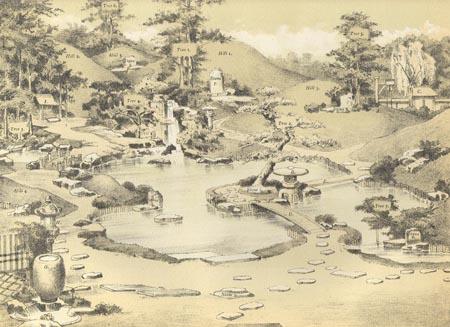
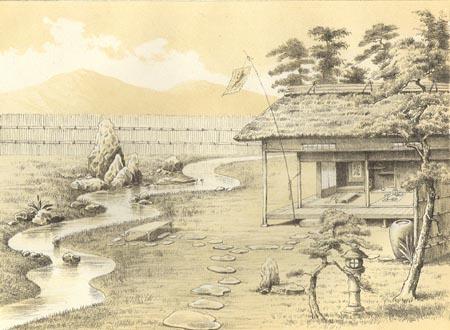
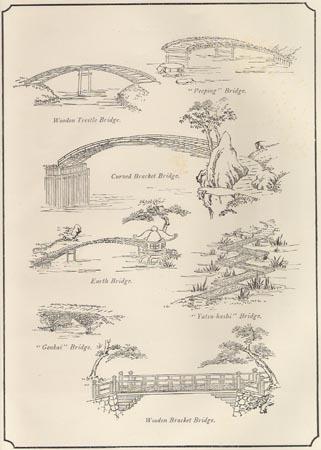
Examples of K. Ogawa Collotypes in Volume 2
(more examples are below)
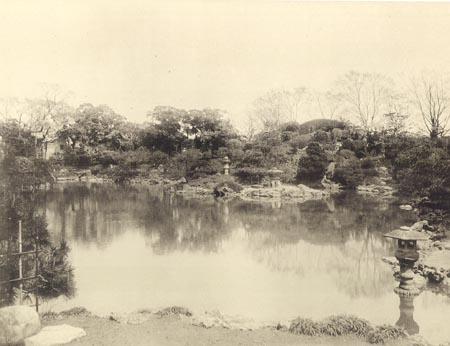
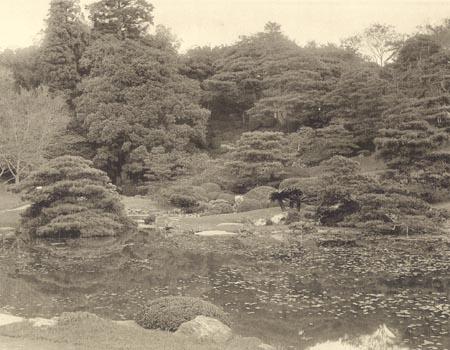
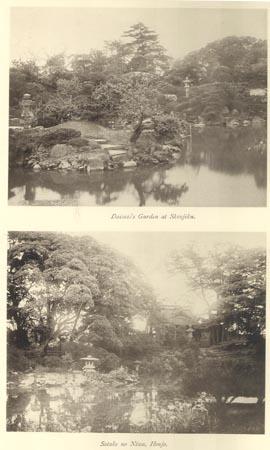
Title Pages
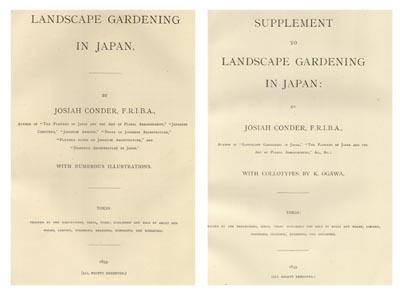
Contents, Volume 1
List of Illustrations
Introduction
CHAPTER I: HISTORY
Origin of Japanese Gardening
Earliest Style
Kamakura Period
Muromachi Period
Influence of the Tea Ceremonial
Gardens of the Tokugawa Times
Tokio Gardens
Kioto Gardens
Provincial Gardens
Descriptions of Fukiage Garden
Hama Rikiu Garden
Shiba Rikiu Garden
Akasaka Rikiu Garden
Koishikawa "Koraku En" Garden
"Horai En" Garden
"Toyama En" Garden
"Yoku on En" Garden
Okayama "Koraku En" Garden
"Hongwanji" Garden
CHAPTER II: GARDEN STONES
Special Importance of Garden Stones
Scale of Stones
Sex of Stones
Symbolism of Stones
Geological Character
Nomenclature
Radical Shapes
Hill Stones
Lake and River Stones
Cascade Stones
Island Stones
Valley Stones
Water Basin Stones
Tea Garden Stones
Stepping Stones
CHAPTER III: GARDEN LANTERNS
Origin of Garden Lanterns
Employment of Garden Lanterns
Materials for Construction
Standard Lanterns
Varieties and Nomenclature
Snow-scene Lanterns
Varieties
Hanging Lanterns
Bronze Lanterns
Grouping of Stones with Lanterns
CHAPTER IV: GARDEN PAGODAS
Religious Origin of Garden Pagodas
Various Shapes of Garden Pagodas
Employment in Gardens
CHAPTER V: GARDEN WATER BASINS
Relation between Basins and Buildings
Use of Garden Basins
Different Shapes of Basins and Nomenclature
CHAPTER VI: GARDEN ENCLOSURES
Enclosing Walls to Gardens
Garden Fences
Wooden Fences
Bamboo Fences
Open Fences
Garden Hedges
Garden Gateways and Gates
Screen Fences
CHAPTER VII: GARDEN WELLS
Purpose of Garden Wells
Arrangement of Garden Wells
Different Forms of Well Frames and Coverings
Well Buckets
Well Drains
CHAPTER VIII: GARDEN BRIDGES
Stone Bridges
Wooden Bridges
Earth Bridges
Rustic Bridges
CHAPTER IX: GARDEN ARBOURS
Open Arbours and Summer-houses
Closed Arbours
Fancy Arbours
Position of Arbours
CHAPTER X: ORNAMENTAL WATER
Importance of Water in Landscape Gardens
Garden Lakes
Garden Cascades
Garden Rivers and Streams
Garden Islands
Duck Ponds
Drainage
CHAPTER XI: GARDEN VEGETATION
Arrangement of Vegetation
Trimming of Trees and Shrubs
List of Garden Trees, Shrubs, and Plants
Evergreens
Deciduous Trees and Shrubs
Flowering Trees and Shrubs
Flowering Plants
Creeping Plants
Large-leaved Plants
Bamboos, Rushes, and Grasses
Selection of Vegetation
Limited Use of Flowering Plants
Trees and Plants in Relation to Special Positions
Proportion of Trees
Pollards
CHAPTER XII: GARDEN COMPOSITION
Preparatory Training for Designing
Out Door Sketching
Examination of the Site
Methods of Designing
Hill Gardens
Flat Gardens
Tea Gardens
Passage Gardens
Fancy Gardens
List of Illustrations.
Plates Volume 1 (37).
Plate
Number
I. Radical Stone Shapes and Double Combinations.
II. Radical Stone Shapes, Triple and Quintuple Combinations.
III. Stepping Stones, General Arrangements.
IV. Stepping Stones, Details.
V. Garden Lanterns, Standard Lantern Class.
VI. Garden Lanterns, Standard and Legged Lanterns.
VII. Garden Lanterns, Fancy Kinds.
VIII. Garden Pagodas, Three and Five Storied.
IX. Garden Water Basins, Fancy Shapes.
X. Garden Water Basins, Showing Method of Arrangement.
XL Garden Fences, Bamboo and Boarded Structures.
XII. Garden Gateways for Fences and Hedges.
XIII. Garden Gateways for Principal Entrances.
XIV. Garden Gates of Boards and Bamboo-work.
XV. Garden Screen Fences, Ordinary Kinds.
XVI. Garden Screen Fences, Ordinary Kinds.
XVII. Garden Fences, Fancy Kinds.
XVIII. Garden Screen Fences, Fancy Kinds.
XIX. Garden Screen Fences, with Stones and Vegetation.
XX. Garden Screen Fences, with Lantern and Basins.
XXI. Garden Wells, Stone and Wooden Frames.
XXII. Wooden Garden Bridges, showing Surroundings.
XXIII. Stone Garden Bridges, showing Surroundings.
XXIV. Garden Arbours, various Designs.
XXV. Diagram of Hill Garden, Finished Style. *
XXVI. Diagram of Hill Garden, Intermediary Style. *
XXVII. Diagram of Hill Garden, Rough Style. *
XXVIII. Diagram of Flat Garden, Finished Style. *
XXIX. Diagram of Flat Garden, Intermediary Style. *
XXX. Diagram of Flat Garden, Rough Style. *
XXXI. Diagram of Tea Garden. *
XXXII. Diagram of Tea Garden Enclosures. *
XXXIII. Diagram of Tamagawa Tea Garden. *
XXXIV. Large Lake Garden. *
XXXV. Sotefsu Garden of the Hongwanji. *
XXXVI. Garden of Ginkakuji, or the "Silver Pavilion." *
XXXVII. Garden Plan
* Plates XXV-XXXVI (12) are tinted lithographs.
All others appear to be woodblock type plates.
Figures Printed with the Text Volume 1 (55).
Figure Number.
1. Page 7. Natural Pine-tree.
2. Page 14. Lake Seiko, China.
3. Page 17. Garden of Banto In, Kioto.
4. Page 22. Grounds of Hoshun In, Daitokuji.
5. Page 23. Entrance Court, Daitokuji.
6. Page 36. Karasaki Pine-tree, Lake Biwa.
7. Page 38. Arbour of the "Floating Wine Cup."
8. Page 40. Summer House, Koraku En.
9. Page 42. Miniature Garden in Water Bowl.
10. Page 43. Religious Arrangement of Stones.
11. Page 56. Garden of a Sakai Merchant.
12. Page 58. Garden of Raked Sand.
13. Page 60. Garden of Zuiun In, Mioshinji.
14. Page 66. Garden of Jojiu In, Kiyomizu.
15. Page 67. Garden belonging to Tei-ami, Maruyama.
16. Page 70. Bronze Basin with Screen Fence.
17. Page 73. Garden Wall with Willow-tree.
18. Page 75. Screen Fence, with Blossoming Trees.
19. Page 76. Tea Garden with Open Bamboo Fence.
20. Page 79. Garden of Kaifuku In, Kioto.
21. Page 80. Garden Fence and Entrance,
with Overhanging Pine.
22. Page 83. Framed Screen Fence.
23. Page 87. Garden Well with Accessories.
24. Page 90. Garden called Sho-fu-tei, Kamakura.
25. Page 91. Garden of Joko In, Miidera Temple.
26. Page 93. Garden Arbour.
27. Page 94. Ancient Garden with Arbour.
28. Page 96. Ancient Temple Garden, Kioto.
29. Page 97. Shapes of Garden Lakes.
30. Page 99. Garden of Kotokuji, Kioto.
31. Page 102. Garden of Jizo In, Mibu.
32. Page 103. Temple Garden, Kioto.
33. Page 106. Saigio Willow-tree.
34. Page 107. Plan showing Method of Planting Trees.
35. Page 107. Saigio Pine-tree, Sagami.
36. Page 108. "Kwannon's Seat" Pine-tree, Sagami.
37. Page 109. Saigio Willow, Ashino.
38. Page 111. Natural Twin Pine-trees.
39. Page 114. Maple-trees of Tsuten, Kioto.
40. Page 116. The "Flying Plum-tree."
41. Page 122. Cherry-trees of Arashiyama.
42. Page 124. Tea Garden with Hills and Cherry-trees.
43. Page 130. "Garden of Limitless View."
44. Page 131. Garden of Tarioji-no-Zushi, Kotokuji.
45. Page 134. Diagram of Land and Water Distribution.
46. Page 144. Tea Garden, Sakai.
47. Page 145. Plans of Tea Rooms.
48. Page 146. Tea Garden at Kitano.
49. Page 147. Garden called Niuwa-tei.
50. Page 148. Tea Garden representing Scenery
near Fujisan.
51. Page 149. Tea Garden representing Yatsuhashi
Landscape.
52. Page 151. "Garden of Mountain Grass."
53. Page 153. Cherry-tree Garden.
54. Page 154. Garden of "Late Spring-time."
55. Page 155. Garden design by Sen-no-Rikiu.
Volume 2 - Illustrations (40)
Full Page black and white collotype Plates primarily from
K. Ogawa photographs [many plates have more than one view]
When plates are listed together below, that means that
one page of descriptive text covers both plates.
PLATE I. Shinobazu-no-ike, Uyeno.
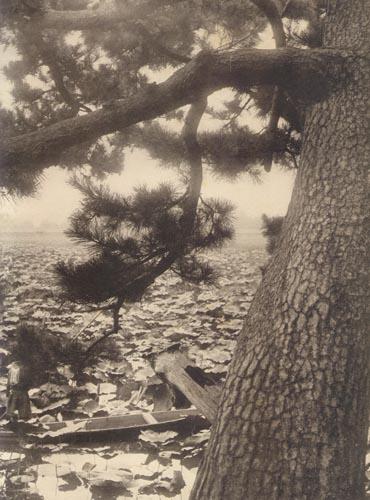 PLATE II. Scenery of Matsushima.
PLATE III. Ishiyama, Cascades, Lake Biwa.
PLATE IV. Natural Cascades, Hakone.
PLATE II. Scenery of Matsushima.
PLATE III. Ishiyama, Cascades, Lake Biwa.
PLATE IV. Natural Cascades, Hakone.
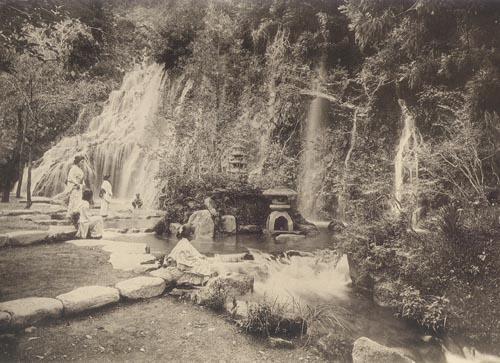 PLATE V. Hama Rikiu Garden.
PLATE VI. Fukiage Garden.
PLATE VII. Ike-no-niwa, Kioto Palace.
PLATE VIII. Kinkakuji Garden, Kioto.
PLATE V. Hama Rikiu Garden.
PLATE VI. Fukiage Garden.
PLATE VII. Ike-no-niwa, Kioto Palace.
PLATE VIII. Kinkakuji Garden, Kioto.
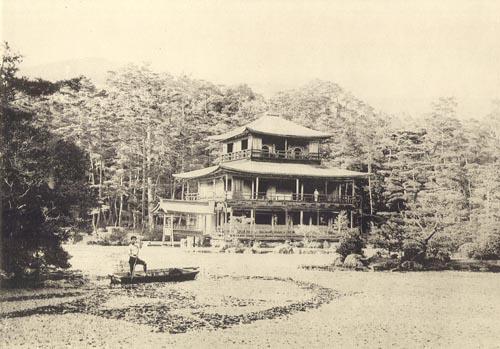 Close-up
Close-up
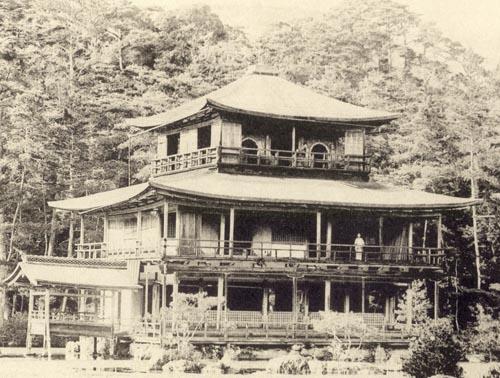 PLATE IX. Ginkakuji Garden, Kioto.
PLATE X. Tokusui-In Garden, Kioto.
PLATES XI. & XII. Koraku-En Garden, Koishikawa.
PLATE XIII. Garden Cascades.
PLATE XIV. Daimio of Mito's Garden, Honjo.
PLATE IX. Ginkakuji Garden, Kioto.
PLATE X. Tokusui-In Garden, Kioto.
PLATES XI. & XII. Koraku-En Garden, Koishikawa.
PLATE XIII. Garden Cascades.
PLATE XIV. Daimio of Mito's Garden, Honjo.
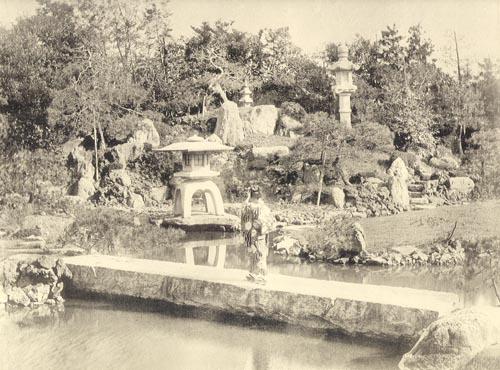 PLATES XV. & XVI. Satake-no-Niwa, Honjo.
PLATE XVII. Hotta-no-Niwa, Fukagawa.
PLATES XVIII. & XIX. Botanical Garden, Koishikawa.
PLATES XX. & XXI. Tsuyama Garden, Tokio.
PLATE XXII. Garden at Komagome.
PLATES XXIII. & XXIV. Gentleman's Garden, Fukagawa.
PLATE XXV. Fukagawa Garden, Details.
PLATE XXVI. Tea Garden, Fukagawa.
PLATES XV. & XVI. Satake-no-Niwa, Honjo.
PLATE XVII. Hotta-no-Niwa, Fukagawa.
PLATES XVIII. & XIX. Botanical Garden, Koishikawa.
PLATES XX. & XXI. Tsuyama Garden, Tokio.
PLATE XXII. Garden at Komagome.
PLATES XXIII. & XXIV. Gentleman's Garden, Fukagawa.
PLATE XXV. Fukagawa Garden, Details.
PLATE XXVI. Tea Garden, Fukagawa.
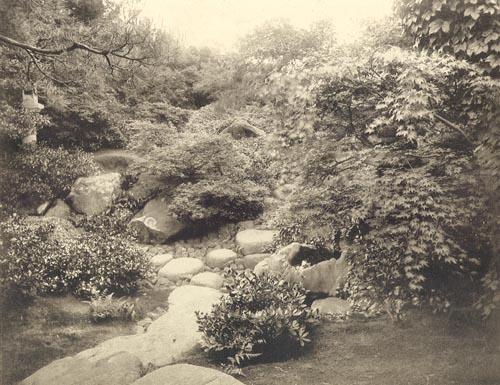 PLATE XXVII. Gentleman's Garden, Bancho.
PLATE XXVII. Gentleman's Garden, Bancho.
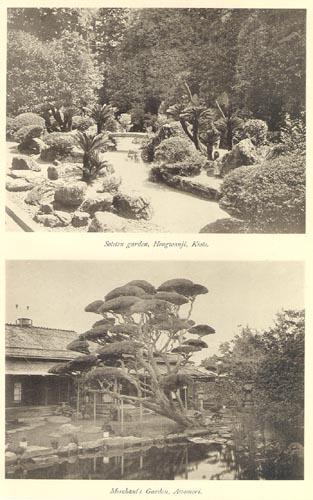 PLATE XXVIII. Merchant's Garden, Fukagawa.
PLATE XXIX. Public Gardens.
PLATE XXX. Tea-house Gardens, Oji.
PLATE XXXI. Okano-no-Niwa.
PLATES XXXII. & XXXIII. Monastery Gardens, Nikko.
PLATE XXXIV. Daimio's Garden, Kanazawa.
PLATES XXXV. & XXXVI. Koraku-En, Okayama.
PLATE XXXVII. Gardens at Kioto and Awomori.
PLATE XXXVIII. Garden at Kagoshima.
PLATE XXXIX. Shirase-no-Niwa, Niigata.
PLATE XL. Garden Rockery, Nedzu.
PLATE XXVIII. Merchant's Garden, Fukagawa.
PLATE XXIX. Public Gardens.
PLATE XXX. Tea-house Gardens, Oji.
PLATE XXXI. Okano-no-Niwa.
PLATES XXXII. & XXXIII. Monastery Gardens, Nikko.
PLATE XXXIV. Daimio's Garden, Kanazawa.
PLATES XXXV. & XXXVI. Koraku-En, Okayama.
PLATE XXXVII. Gardens at Kioto and Awomori.
PLATE XXXVIII. Garden at Kagoshima.
PLATE XXXIX. Shirase-no-Niwa, Niigata.
PLATE XL. Garden Rockery, Nedzu.
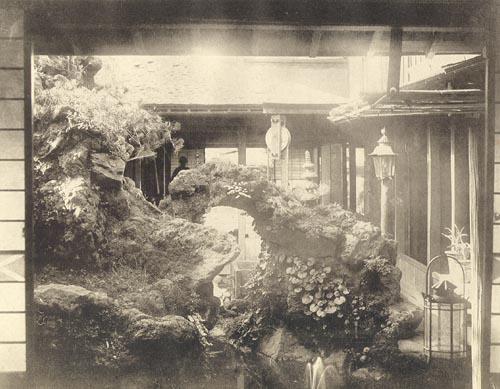
Example of the linen type strip to which plates are attached.
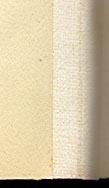
Example of the design on the decorated endpages.
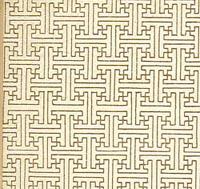
|

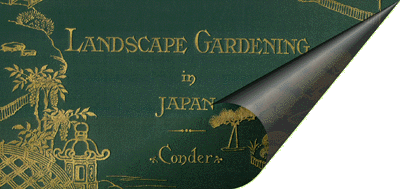







 PLATE II. Scenery of Matsushima.
PLATE III. Ishiyama, Cascades, Lake Biwa.
PLATE IV. Natural Cascades, Hakone.
PLATE II. Scenery of Matsushima.
PLATE III. Ishiyama, Cascades, Lake Biwa.
PLATE IV. Natural Cascades, Hakone.
 PLATE V. Hama Rikiu Garden.
PLATE VI. Fukiage Garden.
PLATE VII. Ike-no-niwa, Kioto Palace.
PLATE VIII. Kinkakuji Garden, Kioto.
PLATE V. Hama Rikiu Garden.
PLATE VI. Fukiage Garden.
PLATE VII. Ike-no-niwa, Kioto Palace.
PLATE VIII. Kinkakuji Garden, Kioto.
 Close-up
Close-up
 PLATE IX. Ginkakuji Garden, Kioto.
PLATE X. Tokusui-In Garden, Kioto.
PLATES XI. & XII. Koraku-En Garden, Koishikawa.
PLATE XIII. Garden Cascades.
PLATE XIV. Daimio of Mito's Garden, Honjo.
PLATE IX. Ginkakuji Garden, Kioto.
PLATE X. Tokusui-In Garden, Kioto.
PLATES XI. & XII. Koraku-En Garden, Koishikawa.
PLATE XIII. Garden Cascades.
PLATE XIV. Daimio of Mito's Garden, Honjo.
 PLATES XV. & XVI. Satake-no-Niwa, Honjo.
PLATE XVII. Hotta-no-Niwa, Fukagawa.
PLATES XVIII. & XIX. Botanical Garden, Koishikawa.
PLATES XX. & XXI. Tsuyama Garden, Tokio.
PLATE XXII. Garden at Komagome.
PLATES XXIII. & XXIV. Gentleman's Garden, Fukagawa.
PLATE XXV. Fukagawa Garden, Details.
PLATE XXVI. Tea Garden, Fukagawa.
PLATES XV. & XVI. Satake-no-Niwa, Honjo.
PLATE XVII. Hotta-no-Niwa, Fukagawa.
PLATES XVIII. & XIX. Botanical Garden, Koishikawa.
PLATES XX. & XXI. Tsuyama Garden, Tokio.
PLATE XXII. Garden at Komagome.
PLATES XXIII. & XXIV. Gentleman's Garden, Fukagawa.
PLATE XXV. Fukagawa Garden, Details.
PLATE XXVI. Tea Garden, Fukagawa.
 PLATE XXVII. Gentleman's Garden, Bancho.
PLATE XXVII. Gentleman's Garden, Bancho.



